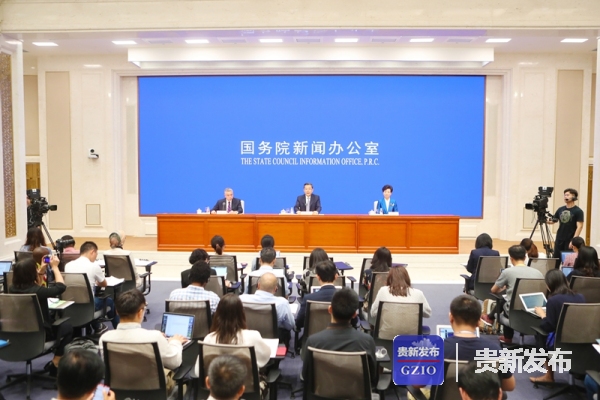
 |
|
Government officials of Guizhou province answer questions from journalists at the news conference. [Photo/gog.cn] |
In celebration of the 70th anniversary of the founding of the People's Republic of China, the State Council Information Office held a news conference on Aug 9, inviting officials of Southwest China's Guizhou to introduce the poverty alleviation efforts in the province and answer questions from journalists.
Over the past 70 years, Guizhou has achieved significant results in poverty alleviation. By 2018, Guizhou's GDP reached 1.48 trillion yuan ($209.94 billion), 2,377 times the GDP in 1949.
Guizhou's economic growth has ranked in the top three in China for eight and half years, and was tops in 2017 and 2018. With the optimization of its economic structure, 7.68 million people moved out of poverty and saw significant improvements in their quality of life.
Guizhou takes poverty alleviation as a priority and is on the path to solving the problem of absolute poverty. To date, Guizhou has constructed 80,000 kilometers in roads, provided convenient transportation for 12 million residents in rural areas, and guaranteed the drinking water safety for 2.79 million people living in rural areas.
Over the past three years, Guizhou has relocated 1.88 million people from poverty-stricken areas, which is the most in China. With industrial reform revitalizing the rural economy, the added value of agriculture has increased by 6.8 percent, tops in China.
While balancing education development at county levels, Guizhou has taken the lead in realizing long-range medical treatment at the provincial, city, county, and township levels.
Since 2012, Guizhou's poverty population has decreased from 9.23 million to 1.55 million, the poverty headcount ratio decreased from 26.8 percent to 4.3 percent, and 33 counties have moved out of the poverty level.
Led by its big data development strategy, Guizhou has promoted the integration of big data and real economy, such as online government services, smart agriculture, tourism, transportation, broadcasting, and television.
Guizhou has accelerated the replacement of traditional economic growth drivers with new modern ones. In 2018, the software and information technology service industry increased by 26.7 percent, the income growth of its telecommunication service topped the country, and the proportion of its green economy reached 40 percent.
Infrastructure achieved accelerated development and great changes have swept both urban and rural areas. In 2018, the length of Guizhou's expressways open to the public totaled 6,543 km, ranking seventh in China. With 18 channels connecting to outside the province, Guizhou is home to 47 bridges that are among the top 100 world famous bridges, earning itself the nickname of "the museum of bridges."
In 2018, the length of high-speed railways in Guizhou amounted to 1,262 km, making the province a hub of high-speed railway transit in southwestern China. It has 11 airports covering all the prefectures and cities in the province, and Guiyang Longdongbao International Airport handled more than 20 million visitors in 2018. The Wujiang River waterway has also opened to the public.
The improvement of Guizhou's transportation has raised the province's strategic status in regional development. To date, it has built 2,634 reservoirs and more than 200 key water projects, effectively solving the water shortage problem in karst landscapes. All the executive villages have been connected with power, cables, and 4G networks.
The province attaches great importance to the balance between economic development and ecological protection. Guiyang has held 10 sessions of the Eco Global Forum and has made great progress in energy conservation and exhaust reduction. In 2018, the rate of good air in areas above county level was more than 97 percent and the rate of good water outside of Guizhou reached 100 percent.
In China, Guizhou has the most world natural heritages. It has achieved a more than 30 percent growth in its number of tourism visitors and tourism revenue respectively for three consecutive years. The province has done a great job in developing itself into a popular tourist destination renowned for its fresh air and comfortable weather.
People's livelihoods have improved greatly. Guizhou has always strived for a better life for its people and made great efforts to improve its education, employment, healthcare for seniors, nurseries for children, and housing. In 2018, the per capita disposable income of urban and rural residents reached 31,592 yuan and 9,716 yuan respectively.
During the past 70 years, Guizhou has witnessed sweeping changes and the province firmly believes that under the guidance of the central government, Guizhou will surely accomplish the tasks of poverty alleviation and building a well-off society, creating a new future where people are well-off and the environment is beautiful.